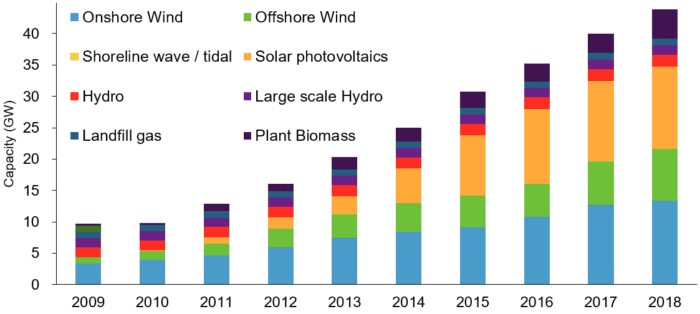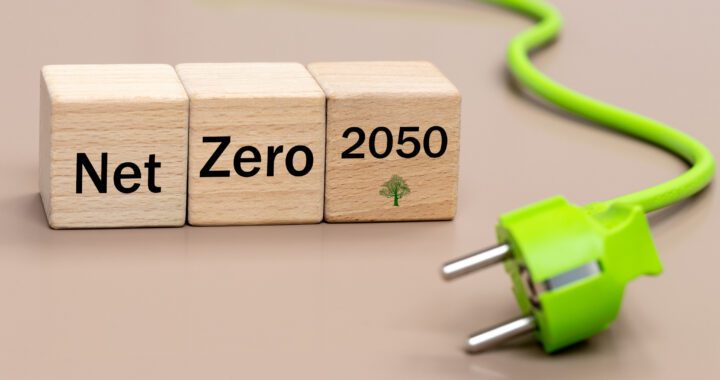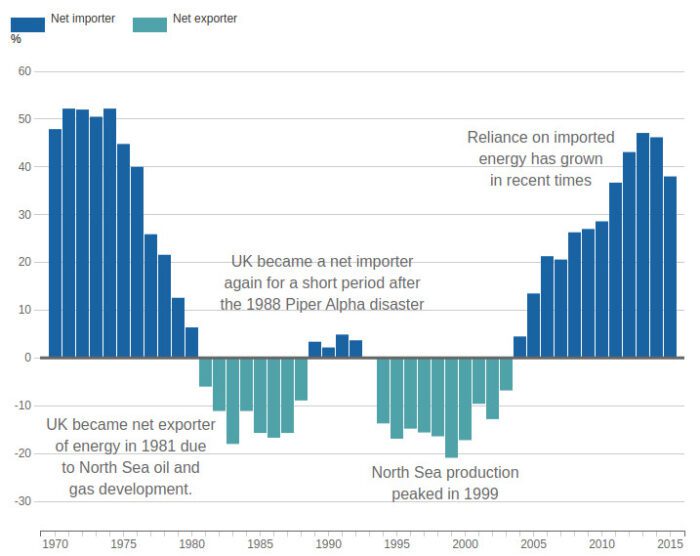The UK target of net zero by 2050, a target set in 2021, well before the current energy crisis has impacted the entire country. The most significant element of acheiving this goal will naturally be a transition to an electricity system that 100% zero-carbon generation most likely from renewable sources and production.
The UK already has renewable energy sources in the electricity mix (the different energy sources that make up the total energy supply), how much are we using now and how much more will be required to reach net zero? Is net zero equal to carbon-neutral?
So what does Net Zero actually mean?
Check out this video from the National Grid.
History of the UK renewable energy growth
In the mid-1990s, the renewable energy started to be a major component of the production of electricity in the United Kingdom and relying on a small amount hydroelectric capacity. The power of wind is the most abundant source of energy in the UK and has become the primary energy source for renewable energy. As of December 2020 renewable sources produced 40.2 percent of the energy generated within the UK; approximately 6.6% of total UK energy consumption.
The interest in renewable energy has grown significantly in recent times due to UK and EU goals for reducing carbon emissions and also incentives from the government for renewable energy sources like Renewable Obligation Certificate scheme (ROCs) and Renewable Obligation Certification scheme (ROCs) and feed in tariffs (FITs), as in addition to for renewable heating such as the Renewable Heat Incentive. The 2009 Directive on Renewable Energy of the EU set a target of reducing 15% in the total energy usage in the UK by 2020.
From 2009 to 2018 the chart shows the growth of the capacity in GW (GigaWatts) from various renewable sources.

Installed capacity (GW) of renewable energy sources in the United Kingdom between 2009 and 2018.[ By Pahazzard] – Own workchart showing renewable installed capacity in the United kingdom, CC BY-SA 3.0
From 2009 to 2018 the chart shows the growth of the electricity genrated in TWh (TerraWatt hours) from various renewable sources.

Electricity generated (TWh) from renewable sources in the United Kingdom between 2009 and 2018 [By Pahazzard] – Own work, CC BY-SA 3.0
UK energy consumption is down as renewable energy up
There was a decline of 17% in the quantity of energy used in thee UK between 1998 and 2015.
This could be explained as follows:
- the increasing use of energy efficient technologies by firms and homeowners
- policies of the government designed to decrease energy consumption
- A decline in UK manufacturing, particularly in industries that require energy
Disco is Dead – UK’s reliance on imported energy rises back up to 1970 levels
Despite the general decline of UK energy consumption, and the rising utilisation of renewable waste burning and renewable sources, the country’s dependence on imported energy has returned to levels it was at in the mid-to-late-1970s.
In recent times, our dependence in imports of energy has been increasing however, it has since slowed from the recent high in 2013.
UK energy import dependency: the percentage of UK energy supply made up of net imports, 1970 to 2015
Where are UK Renewables now?
How much energy is produced via renewable sources now?
Today renewable energy sources account for large proportions of the mix of electricity that power our homes and businesses. In addition, the UK is on the way to developing an electricity nework that is completely made up of renewable sources that are carbon-free and renewable.
2020 was the first time in the UK’s history when electricity was generated mainly from renewable energy and 43% of our electricity coming from bioenergy, wind, solar along with hydroelectric energy sources.
The UK is at the point of producing the trillionth kilowatt hour (kWh) in renewable energy from 1970. It took us 47 years (from 1970 until 2017) to create half a trillion, we’ll be producing the next half-trillion from 2017 and 2023 alone. This will mark a very signifcant shift for the UK.
What has the use we make of renewable energy changed?
In 1991, renewable energy accounted for only 2% of the electricity generation within the UK. By 2013 , that figure was up to 14.6 percent.
During 2017 Britain came in the position of being one of Europe’s leading countries in the expansion of green energy generation. Only countries such as Iceland, Norway and Sweden which had established renewable energy schemes, utilised renewables by scale.
In 2019, zero-carbon electricity production surpassed fossil fuels , for the very first time ever, as on August 17, renewable generation surpassed the largest percentage ever recorded at 85.1 percent (wind 39 percent, solar 25% 20 percent, nuclear 20% and hydro 1 percent).
In the third period of the 2021 quarter, each renewables were responsible for the following:
- Wind energy generated 26.1 percent of the total UK electricity generation in the fourth quarter of 2021. This included offshore and onshore wind producing 14% and 14 percent, respectively.
- Bioenergy The burning of organic substances that are renewable was responsible for 12.7 percent to the total mix of renewable energy.
- The solar power contributed 1.8 percent to the mix of renewables This is an increase of 24% over Q4 2020 due to an 0.7 gigawatt (GW) rise in capacity installed.
- Hydropower which includes tidal was responsible for 2.1 percent to the mix of renewables.
The UK has seen alot of focus on renewables and provided this remains then the taget of net zero should certainly be achievable. The focus not only on renewable energy, but energy efficiency for homes and businesses. For example full cavity and wall insulation can retain approximately 40% more heat than a non-insulated home. There are several government grants available for homes and businesses to improve the energy efficiency.

